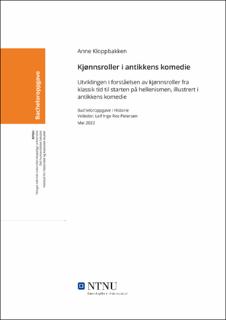| dc.contributor.advisor | Leif Inge Ree Petersen | |
| dc.contributor.author | Anne Kloppbakken | |
| dc.date.accessioned | 2022-06-21T17:19:33Z | |
| dc.date.available | 2022-06-21T17:19:33Z | |
| dc.date.issued | 2022 | |
| dc.identifier | no.ntnu:inspera:110289010:51908833 | |
| dc.identifier.uri | https://hdl.handle.net/11250/2999892 | |
| dc.description.abstract | I denne oppgaven utforskes relasjonen mellom illustrering av kjønnsroller hos antikkens komediediktere og samtidas forståelse av kjønnsroller. Oppgaven bygger på en representasjons analyse av stykkene Lysistrata (411 f.Kr.) av Aristofanes, og Grinebiteren (316 f.Kr) av Menander, med formål å kartlegge hvordan antikkens komedie diktere skildret kjønnet oppførsel og kjønnsroller, hvorav analyse grunnlaget er kjønns teoretikeren Judith Butler sin beskrivelse av det performative kjønn og teori om kjønnsparodi. Formålet med oppgaven er å illustrere bruddet i forståelsen av kjønnsrollene fra klassisk tid til starten på hellenismen grunnet den omfattende samfunnsomveltningen Athen gikk gjennom i dette tidsrommet. Med et bredt kildemateriale, bestående av primærkildene Lysistrata og Grinebiteren og støtte kilder i form av tidligere forskning på kjønnsroller i antikkens samfunn, rammeverket rundt ekteskap og sjangeren komedie sin utvikling, er problemstillingen: Hvordan komedie dikternes skildring av kjønnet oppførsel endret seg fra den eldre til den nye komedie, og hvordan illustrerer det utviklingen i forståelsen av kjønnsrollene fra klassisk tid til starten på hellenismen? | |
| dc.description.abstract | In this thesis, the relationship between the illustration of gender roles in the ancient comedy poets and contemporary understanding of gender roles is explored. The thesis is based on a representation analysis of the pieces Lysistrata (411 BC) by Aristophanes, and Dyskolos (316 BC) by Menander, with the aim of mapping how ancient comedy dictates depicting gendered behavior and gender roles, of which the basis for the analysis is the gender theorist Judith Butler's description of the performative gender and theory of gender parody. The purpose of the thesis is to illustrate the break in the understanding of gender roles from classical times to the beginning of Hellenism due to the extensive social upheaval Athens went through during this period. With a wide range of source material, consisting of the primary sources Lysistrata and Dyskolos and supporting sources in the form of previous research on gender roles in ancient society, the framework around marriage and the development of the comedic genre, the purpose of the thesis to explore: How comedy poets' portrayal of gender behavior changed from the older to the new comedy, and how does it illustrate the development in the understanding of gender roles from classical times to the beginning of Hellenism? | |
| dc.language | nob | |
| dc.publisher | NTNU | |
| dc.title | Kjønnsroller i antikkens komedie
Utviklingen i forståelsen av kjønnsroller fra klassik tid til starten på hellenismen, illustrert i antikkens komedie | |
| dc.type | Bachelor thesis | |
